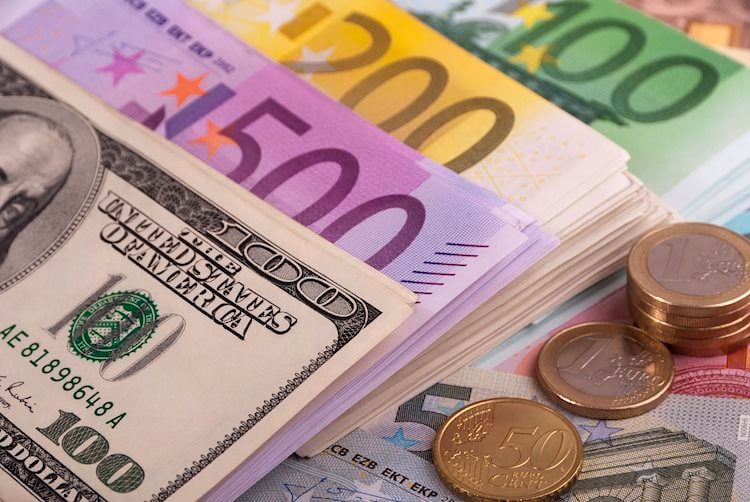- EUR/USD holds steady around 1.0815 in Wednesday’s early Asian session.
- Germany unexpectedly shank by 0.1% in the second quarter.
- The Fed is likely to hold rates steady at its July meeting on Wednesday.
The EUR/USD pair consolidates its losses around 1.0815 during the early Asian session on Wednesday. The major pair edges lower amid risk-aversion and weaker-than-expected preliminary Gross Domestic Product (GDP) for Q2 from Germany. Traders prefer to wait on the sidelines ahead of the Federal Reserve (Fed) Interest Rate Decision on Wednesday.
The German economy fell back into contraction in the second quarter, contracting by 0.1% QoQ after expanding 0.2% in Q1, the first estimate data published by Destatis showed on Tuesday. This figure came in weaker than the expected 0.1% increase. Meanwhile, the annual Gross Domestic Product (GDP) rate dropped by 0.1% in Q2, compared with a 0.2% contraction in Q1 and the 0% forecast. The Euro (EUR) exerted some selling pressure on the downbeat German GDP data.
However, the Eurozone economy expanded by 0.3% in the three months to the end of June, above the market consensus of a 0.2% increase on a quarterly basis. The preliminary inflation data in the broader euro area and Germany’s Retail Sales will be released later on Wednesday. These readings could offer some hints about September’s rate cut by the European Central Bank (ECB).
Across the pond, the Fed is expected to hold interest rates steady at a two-day policy meeting on Wednesday. Nonetheless, the markets widely anticipate the US central bank to start easing its policy at its following meeting in September as inflation easing faster than estimated in June. “At the moment, a modest cut of 25 basis points in September seems likely. If that goes well, we could even see two additional 25 basis point cuts before 2024 comes to an end,” said Jacob Channel, chief economist at LendingTree.
Euro FAQs
The Euro is the currency for the 20 European Union countries that belong to the Eurozone. It is the second most heavily traded currency in the world behind the US Dollar. In 2022, it accounted for 31% of all foreign exchange transactions, with an average daily turnover of over $2.2 trillion a day. EUR/USD is the most heavily traded currency pair in the world, accounting for an estimated 30% off all transactions, followed by EUR/JPY (4%), EUR/GBP (3%) and EUR/AUD (2%).
The European Central Bank (ECB) in Frankfurt, Germany, is the reserve bank for the Eurozone. The ECB sets interest rates and manages monetary policy. The ECB’s primary mandate is to maintain price stability, which means either controlling inflation or stimulating growth. Its primary tool is the raising or lowering of interest rates. Relatively high interest rates – or the expectation of higher rates – will usually benefit the Euro and vice versa. The ECB Governing Council makes monetary policy decisions at meetings held eight times a year. Decisions are made by heads of the Eurozone national banks and six permanent members, including the President of the ECB, Christine Lagarde.
Eurozone inflation data, measured by the Harmonized Index of Consumer Prices (HICP), is an important econometric for the Euro. If inflation rises more than expected, especially if above the ECB’s 2% target, it obliges the ECB to raise interest rates to bring it back under control. Relatively high interest rates compared to its counterparts will usually benefit the Euro, as it makes the region more attractive as a place for global investors to park their money.
Data releases gauge the health of the economy and can impact on the Euro. Indicators such as GDP, Manufacturing and Services PMIs, employment, and consumer sentiment surveys can all influence the direction of the single currency. A strong economy is good for the Euro. Not only does it attract more foreign investment but it may encourage the ECB to put up interest rates, which will directly strengthen the Euro. Otherwise, if economic data is weak, the Euro is likely to fall. Economic data for the four largest economies in the euro area (Germany, France, Italy and Spain) are especially significant, as they account for 75% of the Eurozone’s economy.
Another significant data release for the Euro is the Trade Balance. This indicator measures the difference between what a country earns from its exports and what it spends on imports over a given period. If a country produces highly sought after exports then its currency will gain in value purely from the extra demand created from foreign buyers seeking to purchase these goods. Therefore, a positive net Trade Balance strengthens a currency and vice versa for a negative balance.
